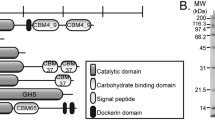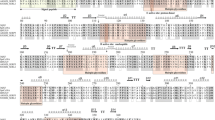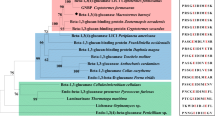Abstract
RsSymEG, an endoglucanase of glycosyl hydrolase family (GHF) 7 encoded by a transcript isolated from the symbiotic protist of the termite Reticulitermes speratus, is expressed in Aspergillus oryzae. Interestingly, purified RsSymEG1 has a relatively higher specific activity (603 μmol min−1 mg−1 protein) and V max value (769.6 unit/mg protein) than previously reported data for GHF7 endoglucanase of Trichoderma ressei. It also has the same K m value (1.97 mg/ml) with Clostridium cellulolyticum enzymes that contain cellulose binding module, a property indicative of high affinity to substrate, though no cellulose binding module is found within it. Thin-layer chromatography analysis revealed that RsSymEG1 preferentially hydrolyzes the β-1,4-cellulosic linkage of cellodextrins into cellobiose and glucose.




Similar content being viewed by others
References
Sanderson, K. (2006). Nature, 444, 673–676. doi:10.1038/444673a.
Yamada, A., Inoue, T., Wiwatwitaya, D., et al. (2005). Ecological Research, 20, 453–460. doi:10.1007/s11284-005-0062-9.
Nakashima, K., Watanabe, H., & Azuma, J.-I. (2002). Cellular and Molecular Life Sciences, 59, 1554–1560. doi:10.1007/s00018-002-8528-1.
Nakashima, K., Watanabe, H., Saitoh, H., et al. (2002). Insect Biochemistry and Molecular Biology, 32, 777–784. doi:10.1016/S0965-1748(01)00160-6.
Breznak, J. A., & Brune, A. (1994). Annual Review of Entomology, 39, 453–487. doi:10.1146/annurev.en.39.010194.002321.
Ohtoko, K., Ohkuma, M., Moriya, S., et al. (2000). Extremophiles, 4, 343–349. doi:10.1007/s007920070003.
Watanabe, H., Nakashima, K., Saito, H., et al. (2002). Cellular and Molecular Life Sciences, 59, 1983–1992. doi:10.1007/PL00012520.
Li, L., Fröhlich, J., Pfeiffer, P., et al. (2003). Eukaryotic Cell, 2, 1091–1098. doi:10.1128/EC.2.5.1091-1098.2003.
Inoue, T., Moriya, S., Ohkuma, M., et al. (2005). Gene, 349, 67–75. doi:10.1016/j.gene.2004.11.048.
Todaka, N., Moriya, S., Saita, K., et al. (2007). FEMS Microbiology Ecology, 59, 592–599. doi:10.1111/j.1574-6941.2006.00237.x.
Zhou, X., Smith, J. A., Oi, F. M., et al. (2007). Gene, 395, 29–39. doi:10.1016/j.gene.2007.01.004.
Archer, D. B., & Peberdy, J. F. (1997). Critical Reviews in Biotechnology, 17, 273–306. doi:10.3109/07388559709146616.
Kitamoto, K. (2002). Advances in Applied Microbiology, 51, 129–153. doi:10.1016/S0065-2164(02)51004-2.
Mabashi, Y., Kikuma, T., Maruyama, J., et al. (2006). Bioscience, Biotechnology, and Biochemistry, 70, 1882–1889. doi:10.1271/bbb.60052.
Sasaguri, S., Maruyama, J., Moriya, S., et al. (2008). Applied Microbiology, 54, 343–351.
Inoue, T., Murashima, K., Azuma, J.-I., et al. (1997). Journal of Insect Physiology, 43, 235–242. doi:10.1016/S0022-1910(96)00097-2.
McIlvaine, T. C. (1921). The Journal of Biological Chemistry, 49, 183–186.
Ståhlberg, J., Divne, C., Koivula, A., et al. (1996). Journal of Molecular Biology, 264, 337–349. doi:10.1006/jmbi.1996.0644.
Henrissat, B. (1991). The Biochemical Journal, 280, 309–316.
Henrissat, B., & Bairoch, A. (1996). The Biochemical Journal, 316, 695–696.
Divne, C., Ståhlberg, J., Teeri, T. T., et al. (1998). Journal of Molecular Biology, 275, 309–325. doi:10.1006/jmbi.1997.1437.
Kleywegt, G. J., Zou, J. Y., Divne, C., et al. (1997). Journal of Molecular Biology, 272, 383–397. doi:10.1006/jmbi.1997.1243.
Ward, M., Lin, C., Victoria, D. C., et al. (2004). Applied and Environmental Microbiology, 70, 2567–2576. doi:10.1128/AEM.70.5.2567-2576.2004.
Van Ardell, J. N., Kwok, S., Schweickart, V. L., et al. (1987). Biotechnology, 5, 60–64. doi:10.1038/nbt0187-60.
Kitamoto, N., Go, M., Shibayama, T., et al. (1996). Applied Microbiology and Biotechnology, 46, 538–544. doi:10.1007/s002530050857.
Kwon, I., Ekino, K., Got'o, M., et al. (1999). Bioscience, Biotechnology, and Biochemistry, 63, 1714–1720. doi:10.1271/bbb.63.1714.
Okada, G., & Nishizawa, K. (1975). Journal of Biochemistry, 78, 297–306.
Okada, G. (1976). Journal of Biochemistry, 80, 913–922.
Fierobe, H. P., Gaudin, C., Belaich, A., et al. (1991). Journal of Bacteriology, 173, 7956–7962.
Fierobe, H. P., Bagnara-Tardif, C., Gaudin, C., et al. (1993). European Journal of Biochemistry, 217, 557–565. doi:10.1111/j.1432-1033.1993.tb18277.x.
Scrivener, A. M., & Slaytor, M. (1994). Insect Biochemistry and Molecular Biology, 24, 223–231. doi:10.1016/0965-1748(94)90001-9.
Watanabe, H., Nakamura, M., Tokuda, G., et al. (1997). Insect Biochemistry and Molecular Biology, I, 305–313. doi:10.1016/S0965-1748(97)00003-9.
Lynd, L. R., Weimer, P. J., van Zyl, W. H., et al. (2002). Microbiology and Molecular Biology Reviews, 66, 506–577. doi:10.1128/MMBR.66.3.506-577.2002.
Qi, Meng, Jun, H., & Forsberg, C. W. (2008). The Journal of Bacteriology, 190, 1976–1984. doi:10.1128/JB.01667-07.
Acknowledgments
This research was partly supported by the New Energy and Industrial Technology Development Organization (NEDO) program for the development of elemental technology for bioenergy conversion. Partial support was also provided by the Eco-molecular Research Program (RIKEN), the Bio-architect Research Program (RIKEN), and the Program for the Promotion of Basic Research Activity for Innovative Biosciences (PROBRAIN). The work described here was conducted as part of a series of studies under the 2005–2006 UNESCO Postgraduate Inter-university Training Course in Biotechnology sponsored by the Japanese Ministry of Education, Culture, Sports, Science and Technology and the Japanese National Commission for UNESCO.
Author information
Authors and Affiliations
Corresponding author
Rights and permissions
About this article
Cite this article
Todaka, N., Lopez, C.M., Inoue, T. et al. Heterologous Expression and Characterization of an Endoglucanase from a Symbiotic Protist of the Lower Termite, Reticulitermes speratus . Appl Biochem Biotechnol 160, 1168–1178 (2010). https://doi.org/10.1007/s12010-009-8626-8
Received:
Accepted:
Published:
Issue Date:
DOI: https://doi.org/10.1007/s12010-009-8626-8




